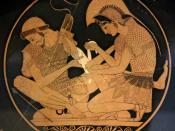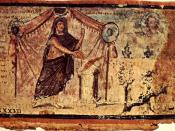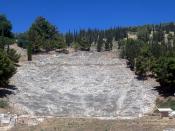The Iliad begins with the story of Achilleus' wrath and ends with the consequences of Achilleus' vengeance. In doing so, the Iliad tells of a hero and his struggle to attain everlasting glory; but its themes are not limited to heroic deeds and events. Additional themes include the relationship of gods and men, the workings of divine justice, and the relationship between passion and anger. Based in part on these themes, the Iliad can be divided in a number of ways. One useful schema divides the Iliad into three movements: withdrawal, devastation, and return. Books 1-9 cover Achilleus' wrath and consequently the battle going unfavorably for the Achaians (the promise of the prologue at 1.1-7); books 10-18 are filled with fighting and end with the death of Patroklos; books 19-24 show Achilleus' glorious return to the fighting and his killing of Hektor. Alternately, the structure of ring composition also provides a useful schema for understanding the Iliad.
As ring composition, the events of the early parts of the work have parallels in the last parts of the work. For example, Achilleus' wrath directed towards Agamemnon (book 1 ff.) parallels Achilleus' wrathful vengeance on Hektor for the killing of Patroklos (book 19 ff.). Also, book 1 begins with Achilleus (1.1) but book 24 ends with Hektor (24.804): the Iliad moves from the hero of the Achaians to the hero of Troy. It also moves from the withdrawal of the greatest hero of the Achaians and the possibility of Achaian failure to the death of the greatest of the Trojans and the future destruction of Troy. The poet's narration moves from a retrospective mode at the beginning (looking back to the cause of Zeus' plan) to a prospective mode at the end (looking into the future to the fall of...


